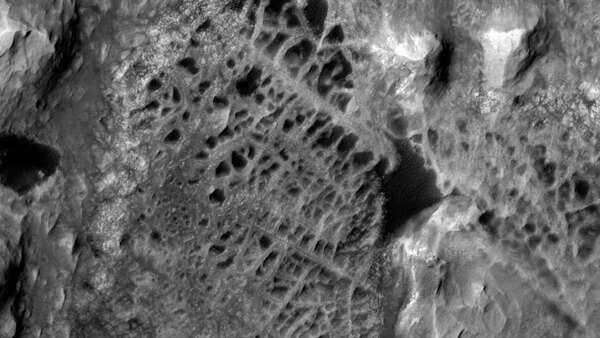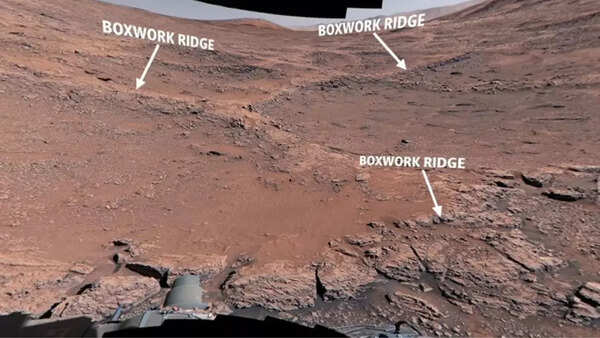NASA's Curiosity rover has made a groundbreaking discovery on Mars, capturing the first close-up images of bizarre, spiderweb-like rock formations. These intriguing structures provide valuable insights into the Red Planet's ancient, water-rich history and its potential to have supported life.
These mysterious, zig-zagging formations, known as "boxwork," were identified on the slopes of Mount Sharp within Gale Crater. Curiosity has been diligently exploring this region since 2012. The intricate, mineral-rich ridges are believed to have originated from ancient groundwater activity. When viewed from above, they strikingly resemble webs. Scientists are optimistic that these formations may hold crucial clues about Mars' capacity to sustain microbial life in the distant past.
Despite their spiderweb-like appearance, these structures are not the work of Martian insects. They are geological features called boxwork, characterized by intersecting mineral ridges. These ridges form when groundwater permeates cracks in the rock, leaving behind mineral deposits. Over time, wind erosion wears away the surrounding softer rock, exposing the hardened, web-like framework underneath.

While boxwork formations have been observed from orbit, this marks the first instance of their close examination on the Martian surface. Curiosity reached this site in early June 2025, following months of traversing Mount Sharp. On June 23, NASA released images and an interactive 3D video of the formations, emphasizing their unique structure and unexplained location as a top scientific priority.

Analysis of the surrounding rocks reveals the presence of calcium sulfate veins, a salty mineral commonly deposited by groundwater. These findings suggest that the area was once abundant in liquid water. The underground environment could have been warm and salty, potentially offering habitable conditions for microbial life, similar to certain regions on early Earth.
It's essential to differentiate the newly imaged boxwork formations from the "spiders on Mars," which are dark, radial patterns caused by carbon dioxide ice erupting from beneath the surface. Unlike those seasonal features, boxwork is a permanent, mineral-based structure formed through geological processes rather than atmospheric ones.
Scientists hypothesize that these formations could play a pivotal role in determining whether Mars once harbored life. The mineral composition, protected underground environment, and evidence of flowing water collectively suggest an environment capable of supporting microbial organisms. According to Curiosity mission scientist Kirsten Siebach, "Early Earth microbes could have survived in a similar environment."
Curiosity will continue its investigation of this boxwork patch on Mount Sharp, collecting samples through drilling and conducting comprehensive chemical analyses. Researchers are hopeful that these unique structures will not only shed light on Mars' climate history but also guide future missions in the search for signs of life beneath the Martian surface.
Newer articles
 Vitamin D Could Slash Tooth Decay Risk by 50%, Study Suggests
Vitamin D Could Slash Tooth Decay Risk by 50%, Study Suggests
 Indian Cricket Star Mukesh Kumar and Wife Divya Singh Announce Birth of Son
Indian Cricket Star Mukesh Kumar and Wife Divya Singh Announce Birth of Son
 Shubman Gill's Captaincy Under Fire: Bold Calls Needed After England Test Defeat
Shubman Gill's Captaincy Under Fire: Bold Calls Needed After England Test Defeat
 Microsoft Aims for Foldable Redemption with Novel Hinge Design to Rival iPhone and Android
Microsoft Aims for Foldable Redemption with Novel Hinge Design to Rival iPhone and Android
 Popular Finance YouTuber's Account Hacked, Bitcoin Scam Promoted: Security Lessons Learned
Popular Finance YouTuber's Account Hacked, Bitcoin Scam Promoted: Security Lessons Learned
 Hollywood's Love Affair with India: Iconic Film Locations Revealed
Hollywood's Love Affair with India: Iconic Film Locations Revealed
 Esha Gupta Breaks Silence on Hardik Pandya Romance Rumors: 'We Were Just Talking'
Esha Gupta Breaks Silence on Hardik Pandya Romance Rumors: 'We Were Just Talking'
 Rishabh Pant Aims to Surpass Virat Kohli in Test Century Tally During England Series
Rishabh Pant Aims to Surpass Virat Kohli in Test Century Tally During England Series
 Prithvi Shaw Credits Sachin Tendulkar's Guidance for Career Revival After Setbacks
Prithvi Shaw Credits Sachin Tendulkar's Guidance for Career Revival After Setbacks
 Ashada Gupt Navratri 2025: Unveiling Dates, Timings, Significance & Secret Rituals
Ashada Gupt Navratri 2025: Unveiling Dates, Timings, Significance & Secret Rituals